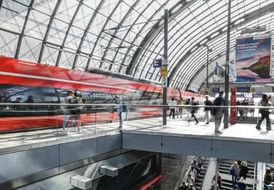Development in the year under review
- Significant increases in revenues from traction current and stationary energy, primarily due to prices.
- One-off effects from the sale of excess energy quantities reduce the burden of higher energy purchase costs.
- Hedging strategy limited the impact of significant price increases on the energy procurement market.
- Supply reliability stable at a high level.
DB Netze Energy | 2022 | 2021 | Change |
2019 | |
absolute | % | ||||
Supply reliability (%) | 99.99 1) | 99.99 1) | – | – | 99.99 |
Customer satisfaction (SI) | 79 | 79 | – | – | 78 |
Customer satisfaction, traction current and diesel | 73 | 77 | –4 | – | 71 |
Customer satisfaction, electricity and gas plus (intra-Group customers) | 79 | 80 | –1 | – | 78 |
Traction current (16.7 Hz and direct current) (GWh) | 7,515 | 7,445 | +70 | +0.9 | 7,986 |
Pass-through traction current (16.7 Hz) (GWh) | 2,353 | 2,281 | +72 | +3.2 | 1,566 |
Stationary energy (50 Hz and 16.7 Hz) (GWh) | 13,809 | 14,070 | –261 | –1.9 | 14,932 |
Diesel fuel (million l) | 382.0 | 389.3 | –7.3 | –1.9 | 410.6 |
Total revenues (€ million) | 4,200 | 3,366 | +834 | +24.8 | 2,812 |
External revenues (€ million) | 2,451 | 1,808 | +643 | +35.6 | 1,308 |
EBITDA adjusted (€ million) | 185 | 254 | –69 | –27.2 | 128 |
EBIT adjusted (€ million) | 103 | 169 | –66 | –39.1 | 43 |
Gross capital expenditures (€ million) | 303 | 340 | –37 | –10.9 | 193 |
Net capital expenditures (€ million) | 75 | 66 | +9 | +13.6 | 61 |
Employees as of Dec 31 (FTE) | 1,943 | 1,900 | +43 | +2.3 | 1,772 |
Annual average employees (FTE) | 1,915 | 1,892 | +23 | +1.2 | 1,751 |
Employee satisfaction (SI) | 4.0 | – | – | – | – |
Share of women as of Dec 31 (%) | 15.0 | 13.9 | +1.1 | – | 13.3 |
Share of renewable energies in the DB traction current mix (%) | 65.2 | 62.4 | +2.8 | – | 60.1 |
1) Preliminary figure (not rounded).
The high level of supply reliability was maintained.
Customer satisfaction was stable at a very good level overall. Intra-Group customers are very satisfied with the employee behavior, service quality and settlement. Responses from non-Group traction current customers were not as good, in particular due to the difficult and tense energy market situation.
Development was uneven in volume terms:
- Traction current: Sales increased primarily due to higher demand in rail passenger transport. A decline in rail freight transport and at external customers had a dampening effect.
- Traction energy for non-Group customers: The increase from the previous year’s level reflects transport growth.
- Stationary energy: Electricity sales fell due to reduced portfolio optimization measures on the energy market.
- Diesel fuel: Demand also declined, driven by developments in freight transport.
Economic development was weaker. The gains on the income side were more than wiped out by increased energy purchase expenses. Operating profit figures fell significantly.
Income increased noticeably:
- Revenues: The increase was driven by a significantly higher price level. In addition, in traction current, higher demand played a key role. This was counteracted by the decline in sales in the stationary energy and diesel fuel sectors.
- Other operating income: In addition to changes in allocation in reporting, the decline (–53.8%/€ –56 million) resulted from the absence of positive one-off effects from the previous year.
On the expense side, there was an increase primarily due to prices:
- Cost of materials: The significant increase (+28.4%/€ +845 million) resulted from the energy purchase expenses as a result of higher purchase prices for traction and stationary energy, as well as energy trading and CO₂ certificates. The price increase in diesel fuels clearly exceeded counteracting effects from declining demand. Expenses from increases in provisions in connection with the investment in the Neckarwestheim joint venture power plant, due to continued operation until April 2023, had an additional negative effect.
- Personnel expenses: The increase (+6.2%/€+9 million) resulted both from wage increases and from an increase in the number of employees.
Other expense items decreased slightly:
- Other operating expenses: Decline (–6.3%/€–8 million) among other things due to the absence of additions to provisions in the previous year and positive effects from impairment on bad debt allowance. This was offset in part by expenses in connection with IT projects and services.
- Depreciation: Slight decline (–3.5%/€ –3 million) of depreciation on intangible assets.
Gross capital expenditures decreased. This was due to the absence of a one-off effect from the activation of a lease contract in the previous year and a decline in project volume from joint projects. Investment grants fell disproportionately as a result of balance sheet date-related factors and higher self-financed capital expenditures. As a result, net capital expenditures increased.
The number of employees increased, primarily in order to implement the higher project volume from the LuFV III.
Employee satisfaction is stable at the high level of 2020.
The share of women increased.
The share of renewable energies in the DB traction current mix in Germany has increased further.


